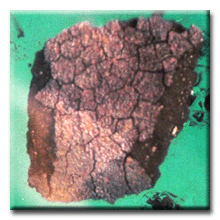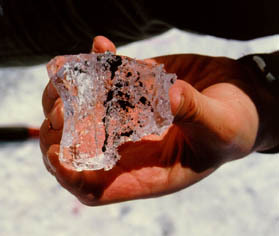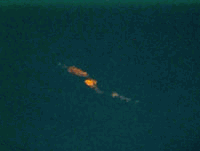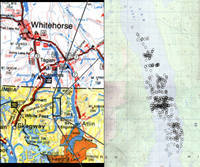
|
| ©University Calgary |
| Close-up of Tagish Lake fragile carbon porousity. |
Around 9:48 on the morning of January 18, 2000, a 150-ton space rock plunged into the earth's atmosphere. As it approached the Canadian remote territories, the meteor traveled at the speed of a fast highway car (67 miles per hour). A scientific consortium of 4 universities and NASA is now trying to uncover the debris and sample the early solar system's unique chemistry.
Indeed, landing between the Yukon Territory and British Columbia in a remote vacation village, the rock volume started its descent totaling about the size of a small truck. At 5 meters (or 15 feet) across, the rocky core triggered Department of Defense satellite sensors to record its fiery explosion near Tagish Lake. The meteor had finally exploded with the energy of two to three kilotons of TNT.
Such fireballs are called bolides, and like the 100,000 or so meteoric streaks that scatter in the upper atmosphere every year, typically don't have either a big enough core or a steep trajectory to survive long to reach land. The rare Tagish Lake fireball left an orange-white and blue contrail that lingered for 10 to 15 minutes as hundreds of observers witnessed the early morning events.
As spectacularly recorded on film an hour before Northern sunrise, the space rock exploded with the force of nearly one-fourth the atmospheric blast power of the Hiroshima nuclear bomb (12.5 kilotons of TNT).
Even with that rocky explosion, however, the first aerial over-flights showed no crater or fragments left to demark the fireball or its impact. But fortunately for the science community, one week later on January 25th, a nearby resident, Jim Brook, found the first meteorite fragments while driving homewards on the ice of Taku Arm in Tagish Lake. He knew the frozen lake well, and had the presence to pick up the dark icy rocks with his hand inside a plastic bag. What Brook had uncovered was an extraterrestrial clue from the early solar system, a 4.5-billion-year-old meteorite.
To date, 500 more fragments have been found near Tagish Lake and hundreds have been recovered from the site - many still encased in ice. The space events of January 18th were the largest ever recorded over land by the Defense Department satellite systems. Scientifically, "[Tagish Lake] is the find of a lifetime," says Peter Brown, meteor scientist in the Department of Physics and Astronomy at The University of Western Ontario and co-leader of the meteorite recovery investigation. "The entire process of recovery of the material and determination of where it comes from makes this the scientific equivalent of an actual sample-return space mission - at a thousandth of the cost."

|
| ©University of Calgary |
| Porous ice makes the Tagish Lake meteors among the most fragile ever found. |
Conclusively, the remarkable luck of landing on a frozen lake, sterile collection and sub-zero storage make the history of the Tagish Lake rocks the most pristine specimen ever studied. Since the rocks never reached elevated temperatures, the frozen gases within the fragments could not boil off or escape detection. What Brown later recorded as "porous ice, I thought that the experience must be a bit like sampling on the surface of a comet. We believe these to be the most fragile meteorites ever recovered".
The delicate charcoal found on Tagish Lake indeed is a rare example of a meteor class called carbonaceous chondrites: meteorites which make up about three per cent of the space rocks recovered. The possible chemical class of this fall constitutes less than 0.1 per cent of all meteorites recovered to date, and represents the most primordial samples known from the early solar system. The largest piece recovered weighed about a half a pound (200 grams) and a total of 2 pounds have been recovered (~1 kg).
It took interested astrobiologists back to a quarter-century earlier, when an Australian space rock called the Murchison meteorite had captured such excitement and anticipation among meteor experts. That largely charcoal rock held some remarkable clues about how life might have begun, since the biochemistry showed signs of amino acids, the simple building blocks of proteins for cells. Prior to Murchison, the fiery descent through the atmosphere was thought widely to heat rocks well beyond the breakdown of organic molecules.
A consortium of chemists and meteor scientists set out to take a small interior cut from the Tagish Lake (TL) rock. As detailed in a recent Science article, the team including 4 universities on both coasts and NASA Ames Research Center analyzed that pristine interior. As described by Sandra Pizzarello, a Research Professor, in the Dept. of Chemistry and Biochemistry, Arizona State University, Tagish Lake promised new insight into the earliest solar system. "As for the TL organic composition, it's hard to choose between the many surprising features."

|
| ©Ewald Lemke |
| Animated gif showing Tagish meteorite smoke trail recorded over 14 minutes on January 18, 2000. |
Unlike Murchison, the Tagish Lake meteor shows no signs of amino acids, but shows a number of cyclic and ring-aromatic carbon chains. Evidence of carbon buckeyballs, or fullerenes, have a characteristic cage-like connections that resemble the geodesic domes promoted by architect and futurist, Buckminster Fuller.
"This is the material", says Pizzarello, "also containing embedded 'exotic' (i.e. possibly presolar) components as: nanodiamonds and fullerenes. Fullerenes are, like diamonds and graphite, a pure carbon phase. They have a distinctive "soccer ball" cage structure of up to hundreds of carbon atom that can retain other atoms and molecules, as those of the noble gasses. In TL the distribution of the cages is different from, for example, from that seen in Murchison as to which cages are predominant. However the noble gasses composition falls well between the values observed for other meteorites."
Compared to Murchison, Tagish Lake rocks reflect a distinct evolutionary branch for carbon in the early solar system. What carbon-rich material that is soluble, shows a more primitive, less complex category of chemistry. "Very interesting is the presence in TL, and other meteorites, of compounds called pyridine carboxylic acids. The simplest compound of this kind is nicotinic acid, which is represented widely in the biosphere as a metabolite. This feature I would also call distinctive."
What's Next?

|
| ©UFOBC.ca |
| Debris pattern for the 500 Tagish meteor fragments as atmospheric friction broke the source rock up at high speeds. |
In the two years since its explosive landing on the scientific scene, Tagish Lake has become famous: the most pristine, the largest tracked by satellites, the most fragile, one of the oldest, and full of exotic chemistry.
With the scientific consortium looking at Tagish Lake rocks, Pizzarello will soon publish results of how water and carbon might have interacted in the early solar system sample "Together we have just completed a study of the dicarboxylic acids of TL (that will appear on the May 2002 issue of Meteoritics and Planetary Sciences devoted exclusively to TL) which presents the very first analyses of the hydrogen isotopic composition of individual meteoritic compounds." Heavy hydrogen (like deuterium or tritium) can help trace the presence of water or other compounds important to future meteor studies.
Other members of the research team include Yongsong Huang from the Department of Geological Sciences at Brown University; Luann Becker from the Institute for Crustal Studies at the University of California Santa Barbara; Robert J. Poreda from the Department of Earth and Environmental Sciences, University of Rochester; George Cooper from the NASA Ames Research Center; and Ronald A. Nieman and Michael Williams, both also from ASU.



Reader Comments
to our Newsletter